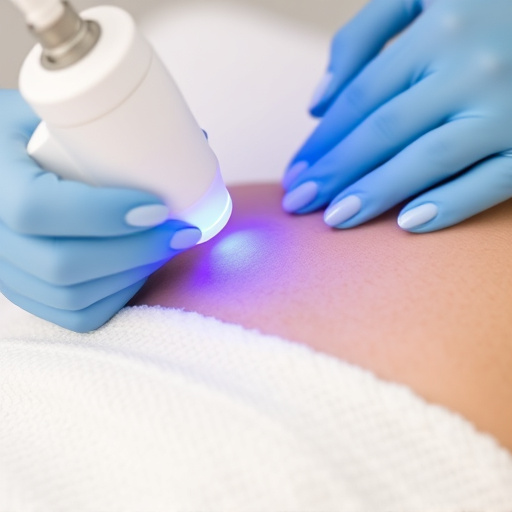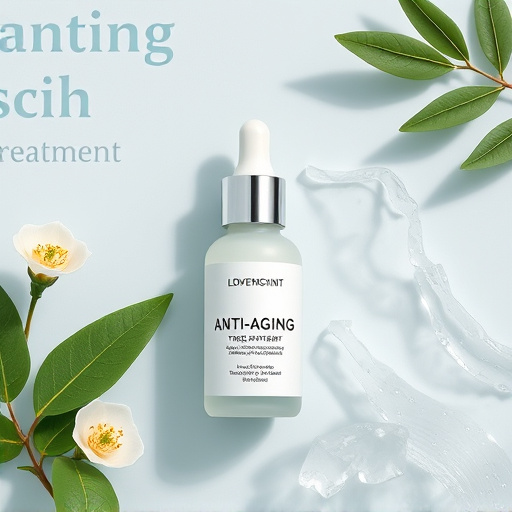Select the Ideal Clinic for Full Body Laser Hair Removal
Full body laser hair removal offers a permanent solution for smooth, hair-free skin, reducing groomi…….
In an era where personal care and aesthetic treatments are gaining prominence, full body laser hair removal has emerged as a game-changer in the beauty and wellness sector. This innovative procedure promises permanent hair reduction across multiple body areas, offering individuals a more efficient and long-lasting alternative to traditional methods. The article delves into the intricacies of full body laser hair removal, exploring its definition, global impact, technological progressions, regulatory landscape, and its transformative potential. By examining these aspects, we aim to provide readers with a comprehensive understanding of this rapidly evolving industry.
Definition: Full body laser hair removal (FBLHR) is a non-invasive aesthetic procedure that utilizes concentrated light energy to target and destroy hair follicles, leading to significant and lasting reduction in hair growth. This process involves advanced laser technology, which emits light at specific wavelengths to penetrate the skin and reach the follicle, thereby inhibiting future hair production.
Core Components: The key components of FBLHR include:
Laser Technology: Different laser types such as Nd:YAG (Neodymium-doped Yttrium Aluminum Garnet) and Diode lasers are employed, each with unique characteristics for treating various skin types and hair colors.
Targeted Hair Follicles: The laser energy is absorbed by melanin in the hair follicle, causing damage to the follicle and its surrounding structures, ultimately suppressing hair growth.
Permanent Hair Reduction: Unlike waxing or shaving, FBLHR aims for long-term hair reduction, with multiple sessions required to treat all follicles and ensure minimal regrowth.
Historical Context: The concept of laser hair removal dates back to the 1960s when early laser devices were used for medical purposes. However, it was in the late 1990s that technological advancements led to the development of more efficient systems suitable for aesthetic applications. Over time, FBLHR has evolved, becoming safer, faster, and more accessible, revolutionizing the way people manage unwanted body hair.
Full body laser hair removal has garnered significant worldwide attention, with varying levels of adoption across regions:
North America: Leading the global trend, the United States is home to a robust FBLHR industry, with advanced clinics offering cutting-edge technology. The region’s strong focus on personal care and aesthetics drives market growth.
Europe: Countries like Germany, France, and the UK have embraced FBLHR, with a growing number of specialized clinics. Strict cosmetic regulations in Europe ensure high safety standards, fostering consumer confidence.
Asia Pacific: This region, including countries like Japan, South Korea, and Australia, is witnessing rapid growth in FBLHR due to increasing disposable incomes and a rising demand for advanced beauty treatments.
Latin America and Middle East: These markets are also experiencing growth, with growing awareness about personal grooming and a preference for permanent hair reduction solutions.
Trends Shaping the Industry:
Non-Invasive Procedures: There is a global shift towards non-surgical, non-invasive beauty treatments, positioning FBLHR as a preferred choice for those seeking long-term solutions without downtime.
Technology Integration: Continuous technological advancements in laser systems, such as improved precision, faster treatment times, and enhanced safety features, are driving market growth and attracting younger demographics.
Personalized Treatments: Clinics are offering tailored FBLHR plans based on individual needs, skin types, and hair characteristics, ensuring optimal results for diverse clientele.
The full body laser hair removal market operates within a dynamic economic ecosystem:
Market Dynamics: The global FBLHR market is characterized by high competition, with various players offering different technologies and treatment packages. Market penetration is significant in mature regions like North America and Europe, while emerging markets in Asia Pacific and the Middle East show promising growth potential.
Investment Patterns: Significant investments are directed towards research and development of advanced laser systems, clinical trials, and marketing campaigns to create brand awareness. Private equity firms often fund start-up clinics, contributing to market expansion.
Economic Impact: FBLHR contributes to economic growth by creating employment opportunities in clinic operations, sales, and customer service. It also fosters related industries like skincare product development and beauty retail.
Price Factors: Treatment costs vary based on region, clinic reputation, technology used, and the scope of services offered. On average, a full body laser hair removal session can range from $200 to $1000, depending on the area treated and the number of sessions required.
Technological breakthroughs have been pivotal in shaping the FBLHR industry:
Laser Technology Evolution: The development of more powerful yet safer laser systems is a significant milestone. Modern lasers offer improved precision, allowing for targeted treatment of small areas and minimizing damage to surrounding skin.
Cooling Systems: Incorporating cooling mechanisms during treatments ensures patient comfort and reduces the risk of skin burns, making FBLHR accessible to a broader range of individuals.
Handheld Devices: Portable, handheld laser devices have entered the market, providing at-home treatment options for those seeking convenience and privacy. These devices offer basic permanent hair reduction but may require more sessions.
AI Integration: Artificial intelligence is being explored for personalized treatment planning, allowing clinics to analyze client data and recommend tailored FBLHR strategies.
Future Prospects: Research focuses on developing lasers with broader applications, faster treatment times, and enhanced targeting capabilities. The integration of virtual reality for pain management and improved patient experiences is also an area of interest.
The regulatory landscape surrounding FBLHR varies across jurisdictions:
International Standards: Organizations like the International Standardization Organization (ISO) have developed guidelines for laser safety, ensuring consistent quality and patient protection worldwide.
Regional Regulations: In Europe, the Medical Devices Regulation (MDR) sets strict standards for medical devices, including lasers used in aesthetic procedures. The US Food and Drug Administration (FDA) regulates laser devices, requiring clinical studies and approval for specific applications.
Licensing and Certification: Clinics offering FBLHR must obtain licenses and certifications from local health authorities, ensuring compliance with safety protocols and sterilization standards.
Informed Consent and Patient Rights: Regulators emphasize the importance of informed consent, where patients fully understand the procedure’s risks, benefits, and potential side effects. Patient privacy and data protection are also paramount in the digital age.
Despite its popularity, FBLHR faces several challenges:
High Treatment Costs: The initial investment for laser devices and clinic setup is substantial, making it a capital-intensive business. This leads to higher treatment costs, which may limit accessibility for some individuals.
Skin Irritation and Allergic Reactions: While cooling systems have improved comfort, skin irritation and allergic reactions remain potential side effects, requiring proper pre and post-treatment care.
Variable Results: Hair growth varies among individuals, and certain skin types or hair colors may not respond as well to laser treatment, leading to inconsistent results.
Regulation and Standardization: Inconsistent regulations across regions can create challenges for clinics expanding globally. Standardizing safety protocols and device performance is essential for patient trust and industry growth.
Overcoming Challenges:
Affordability Strategies: Offering flexible payment plans, promotions, or discounted packages can make FBLHR more accessible.
Skin Care Education: Providing pre- and post-treatment skin care guidance helps minimize side effects and improves client satisfaction.
Continued Research: Investing in research to understand hair growth patterns and develop targeted laser treatments will enhance effectiveness and reduce variability.
Case Study 1: Clinic X – Global Expansion
Location: New York, USA; London, UK; Tokyo, Japan.
Story: Clinic X began as a niche FBLHR clinic in New York, gaining popularity for its advanced technology and personalized service. Through strategic partnerships and successful marketing, they expanded globally within five years. By adapting their services to local preferences and regulations, they established a strong presence in the UK and Japan. This case highlights the potential for international growth in the industry.
Case Study 2: Community-Based Approach
Initiative: “Shave Free Community” – a non-profit organization offering FBLHR to underprivileged women.
Impact: This initiative addresses body hair stigma and provides permanent solutions for those who cannot afford traditional treatments. It has received widespread recognition, fostering conversations about inclusivity and accessibility in the beauty industry.
Case Study 3: Technological Innovation
Company: LaserTech Innovations (fictitious).
Invention: Developed a portable, home-use laser device with AI-assisted treatment planning, allowing users to manage unwanted body hair conveniently and affordably.
Market Response: The device became an instant success, appealing to younger demographics seeking at-home solutions. This case demonstrates the market potential for innovative, consumer-centric technologies.
The future of full body laser hair removal is promising, with several growth areas and emerging trends:
Advanced Laser Technologies: The development of lasers with enhanced targeting capabilities and faster treatment speeds will attract more clients seeking efficient procedures.
Telemedicine Integration: Virtual consultations and remote monitoring can expand access to FBLHR, especially in underserved regions or for individuals with limited mobility.
Personalized Medicine: Tailoring treatments based on genetic profiles, skin types, and hair characteristics will optimize results and reduce treatment times.
Combination Therapies: Combining FBLHR with other aesthetic procedures like skincare treatments or makeup application could offer comprehensive beauty solutions.
Global Market Expansion: Emerging markets in Asia Pacific, Latin America, and the Middle East are expected to witness significant growth due to increasing disposable incomes and a growing demand for advanced beauty services.
Full body laser hair removal has emerged as a revolutionary procedure, offering individuals permanent solutions to manage unwanted body hair. Its global impact is evident in the diverse adoption rates across regions, driven by technological advancements, economic opportunities, and changing consumer preferences. As the industry continues to evolve, addressing challenges through innovation, education, and regulation will be crucial.
The case studies presented highlight successful applications, demonstrating the potential for FBLHR to transform personal care routines and empower individuals. By embracing future trends, such as advanced technologies, telemedicine, and personalized treatments, the FBLHR industry is poised to shape the beauty and wellness landscape for years to come.
Q: Is full body laser hair removal painful?
A: While it may cause temporary discomfort, modern cooling systems help minimize pain during treatment. Topical anesthetics can also be applied before the procedure.
Q: How many sessions are typically required for permanent results?
A: The number of sessions varies based on skin type, hair color, and body area treated. On average, 4-8 sessions spaced several weeks apart are needed for optimal results.
Q: Is FBLHR suitable for all skin types?
A: Advanced lasers have improved their effectiveness across various skin tones, but lighter skin with finer hair may yield better results. It’s essential to consult a professional for personalized recommendations.
Q: Can I perform at-home laser hair removal safely?
A: Portable home devices are available, but they offer basic permanent hair reduction. Professional FBLHR ensures safer and more effective treatment with advanced technology and expert guidance.
Q: How does FBLHR compare to other hair removal methods?
A: FBLHR provides permanent results, making it a long-term solution compared to shaving or waxing, which are temporary. It also offers faster and more convenient alternatives to threading or sugar waxing.

Full body laser hair removal offers a permanent solution for smooth, hair-free skin, reducing groomi…….

Full body laser hair removal is a non-invasive, permanent solution for unwanted hair, using concentr…….

Full body laser hair removal, though popular and generally safe, poses potential risks like skin irr…….